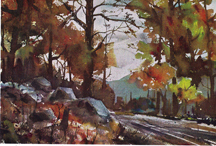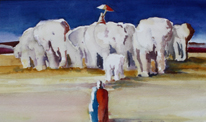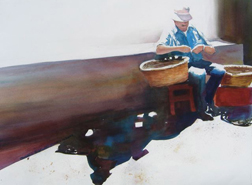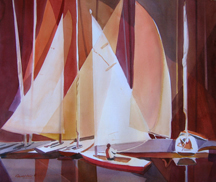 demonstration of the four compositions: cruciform, horizontal banded, frame within a frame, and vertical banded (incomplete)
demonstration of the four compositions: cruciform, horizontal banded, frame within a frame, and vertical banded (incomplete)
As an Art History major in college, I was aware of how composition often defined an artist and an age. When I became serious about my own painting I wanted compositional guidelines that were never forthcoming from my teachers.
The first teacher who offered some guidance was Ed Whitney who taught us to design our paintings by considering the shapes of the darks, the lights and the mid-tones. This was discussed approach was discussed in Composition I, see below, October 2012. I still make this kind of plan or study before painting.
To review: You plan the shapes of the lights, which lead the viewer through the painting, the darks which are the presenters, and the midtones which are the important transitional values. And there is color composition!
 Most of my early work followed Whitney’s direction of entering from the bottom, in, filling the corners with out of focus shapes and darker values, and leading the viewer through to the focal point with the lighter shapes, allowing some escape of light toward the top or sides in a pleasing senuous manner.
Most of my early work followed Whitney’s direction of entering from the bottom, in, filling the corners with out of focus shapes and darker values, and leading the viewer through to the focal point with the lighter shapes, allowing some escape of light toward the top or sides in a pleasing senuous manner.
Ed Whitey’s Autumn Woods.
When we moved to the West Coast, I started studying with Rex Brandt. One summer when I arrived at Carona del Mar for the two-week workshop, Brant announced that he had spent much of the winter going through his books on art. He had come to the conclusion that there were four major designs used again and again and again: horizontal banded, vertical banded, frame-within-a-frame or arabesque, and. Here was some structure! some real guidelines.
HORIZONTAL BANDED:


Horizontal is flat. Horizontal is peaceful, restful. We are horizontal when we lie down. Also when we are dead. It can be boring or tranquil, bucolic, calming. Rarely dramatic.It goes on and on, implying space beyond the frame.


The secret: the width of the bands. Ganging your focal shapes up on the most important band – which can be placed high or low.
VERTICAL BANDED:
 Vertical can be elegant, aristocratic, inspirational, organic, awe-inspiring, or threatening. Cityscapes, forests, many portraits (how wide the negative space on either side of the figure? where place the figure) are all naturals for vertical compositions.
Vertical can be elegant, aristocratic, inspirational, organic, awe-inspiring, or threatening. Cityscapes, forests, many portraits (how wide the negative space on either side of the figure? where place the figure) are all naturals for vertical compositions.


notice deliberate placements to continue vertical themes.
The secret is again the width of the bands; one most important vertical shape; no more than two “supporting actors” and the rest chorus. Be aware of setting up interesting variations in shapes and sizes of negative and positive vertical divisions.


two vertical banded compositions. Check widths of trees and negative areas;
The secret is in the variety of shapes – particularly in their widths. The decision about color and values is a separate consideration.
FRAME WITHIN A FRAME, OR ARABESQUE
 This is the compositional format that Ed Whitney almost always used. Ansel Adams used it, sometimes holding a small branch in front of the lens to help frame his landscape on the top edge. It can easily create the illusion of depth, leading us back into the middle ground or further: the house in the woods, the fisherman in the stream, the workers on a boat or in a field. There has been a turning away from this compositional format as people associate it
This is the compositional format that Ed Whitney almost always used. Ansel Adams used it, sometimes holding a small branch in front of the lens to help frame his landscape on the top edge. It can easily create the illusion of depth, leading us back into the middle ground or further: the house in the woods, the fisherman in the stream, the workers on a boat or in a field. There has been a turning away from this compositional format as people associate it  with the paintings of the mid-century and the romantics of the late 19th and early 20th century. However, I was just told by a recent juror of a show how he liked the award-winning painting for the way it drew the viewer in.
with the paintings of the mid-century and the romantics of the late 19th and early 20th century. However, I was just told by a recent juror of a show how he liked the award-winning painting for the way it drew the viewer in.
The important component is the movement. How do you “walk” visually through the painting? If you feel it is a circular, a spiral, or an S movement that takes you through and around, then it is this composition. Corners are framing, unimportant in themselves, You are led around and to the focal area.

See if you can understand why I chose Trail to the Falls, The Hammock Beckons and Fast Finish to illustrate the arabesque.
THE CRUCIFORM


When I went to the American Watercolor Society exhibits in the early 1970’s, I said to myself, there is a composition here that we didn’t study in art history. I called it the Hanging T. The corners of the painting were empty. There was a major movement from the bottom of the paper to a horizontal banded line, usually above the midline of the painting. Rex referred to this design as a Cruciform design.
A major vertical line of shapes and movement are crossed by a horizontal line of shapes. The focus of the painting is where the two cross. He claimed that the vertical movement continued above the horizontal crossing.
 I found this idea exciting an different. The painting to the right was completed from some studies at a Brandt workshop on Orcas Island. He claimed I was taking this design in directions different from what others have done. I found it exciting and have spent some time exploring it.
I found this idea exciting an different. The painting to the right was completed from some studies at a Brandt workshop on Orcas Island. He claimed I was taking this design in directions different from what others have done. I found it exciting and have spent some time exploring it.


See if you can see why these 5 paintings are placed in the Cruciform section. What is the major vertical movement? Not always obvious: – with the sailcover, it starts 1/5 of the way up the left side. What is the major horizontal subject? Is the focal area where they cross?
How do you use this information to help you when designing your own paintings?
- Ask yourself what is the ONE shape or area that is the subject of this painting. CHOOSE! Be clear. Even write it down.
- Start drawing – not on your watercolor paper but in your sketchbook
- Draw that most important shape toward the middle of your page. Draw it rather small 2-3 inches.
- Chose shapes that combine with it — overlaps and underlaps.
- As you work, notice what is happening and then DECIDE.
- Don’t draw your edge or frame around your drawing until you have found whether it works best horizontally or vertically; more square or elongated;
- keep it simple; keep it clean and clear
 If it is moving toward horizontal bands —
If it is moving toward horizontal bands —
- load the main band with the majority of interesting shapes.
- Eliminate them from the other bands.
- vary the widths of the bands; have interesting value and color differences
 don’t scatter “things” on the other bands — very distracting
don’t scatter “things” on the other bands — very distracting
If it is moving toward vertical bands
- Know which is your most important shape or band; be careful in the placement
choose Star, two supporting actors, chorus
again – vary widths; have interesting value and color differences
If you find you are framing in or developing a curving movement – an arabesque
- pay attention to the direction or path of that movement; perhaps keep it a mainly light shape; have the lightest light against the darkest dark where it brings it to your focal shape
- fill in the corners with unimportant, unfocused, darker framing devices more in middle and dark values
And, if you discover you have a stong vertical movement crossing a strong horizontal band – a cruciform
- pay attention to those two developments, moving shapes into them
- eliminate clutter from the corners
- have your focus where the two major movements cross
- these horizontal and vertical axis do not need to be at 90 degrees from each other

Only when you are clear about your plan, draw it up on your watercolor paper.
 Or – if this is too much work. Do a watercolor sketch or study. No composition. Leave the planning to when you have more time. Capture the light. Capture the feel. Get the information. But one of these days you are going to need to plan. Then remember the help of the four compositional formats and see what you can do with them.
Or – if this is too much work. Do a watercolor sketch or study. No composition. Leave the planning to when you have more time. Capture the light. Capture the feel. Get the information. But one of these days you are going to need to plan. Then remember the help of the four compositional formats and see what you can do with them.
Happy painting!
Caroline
© 2013 Caroline Buchanan
